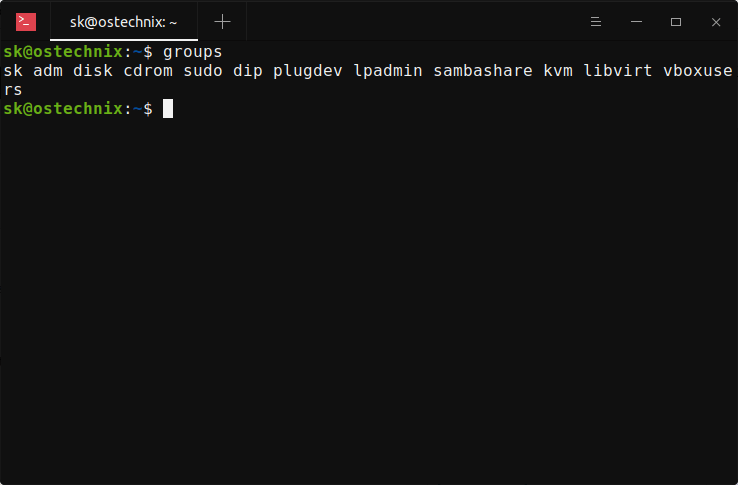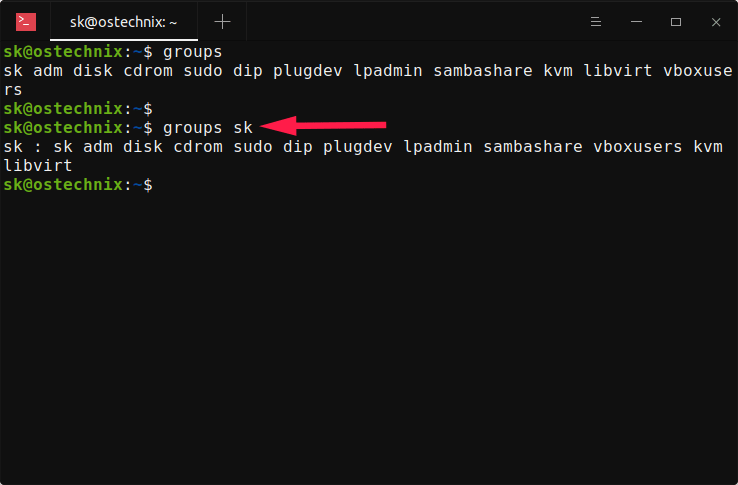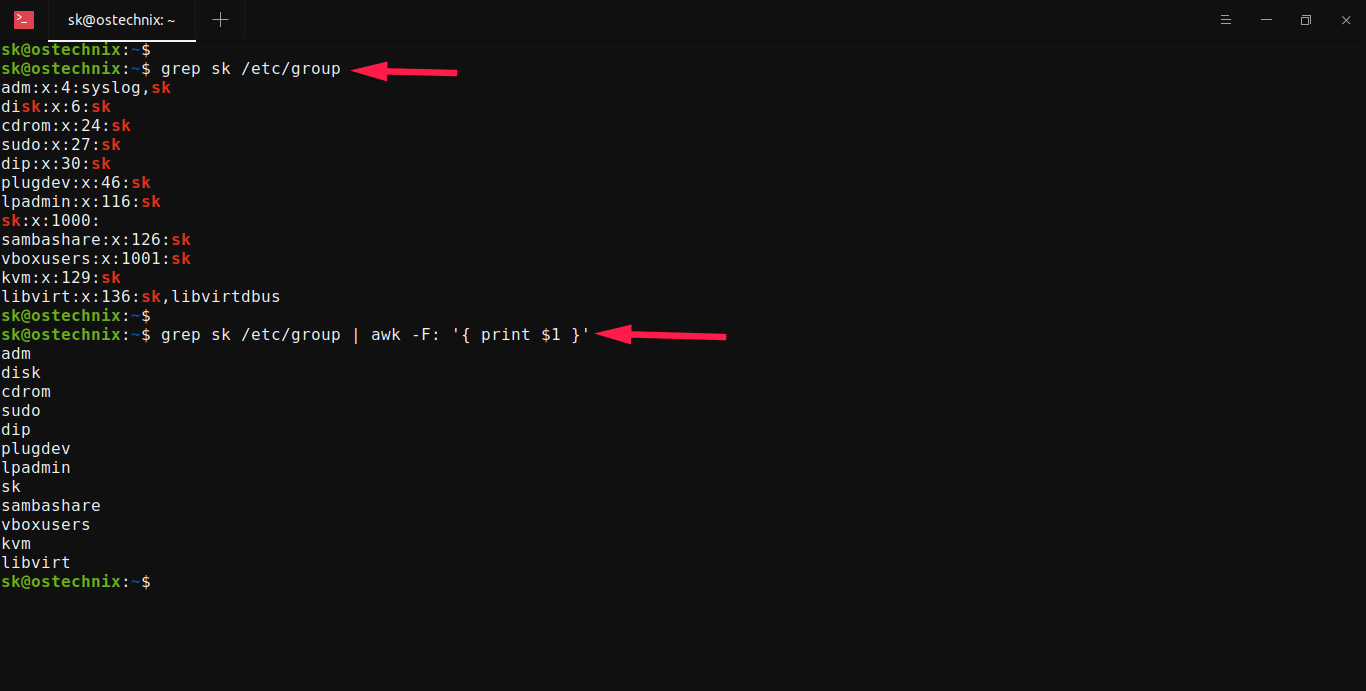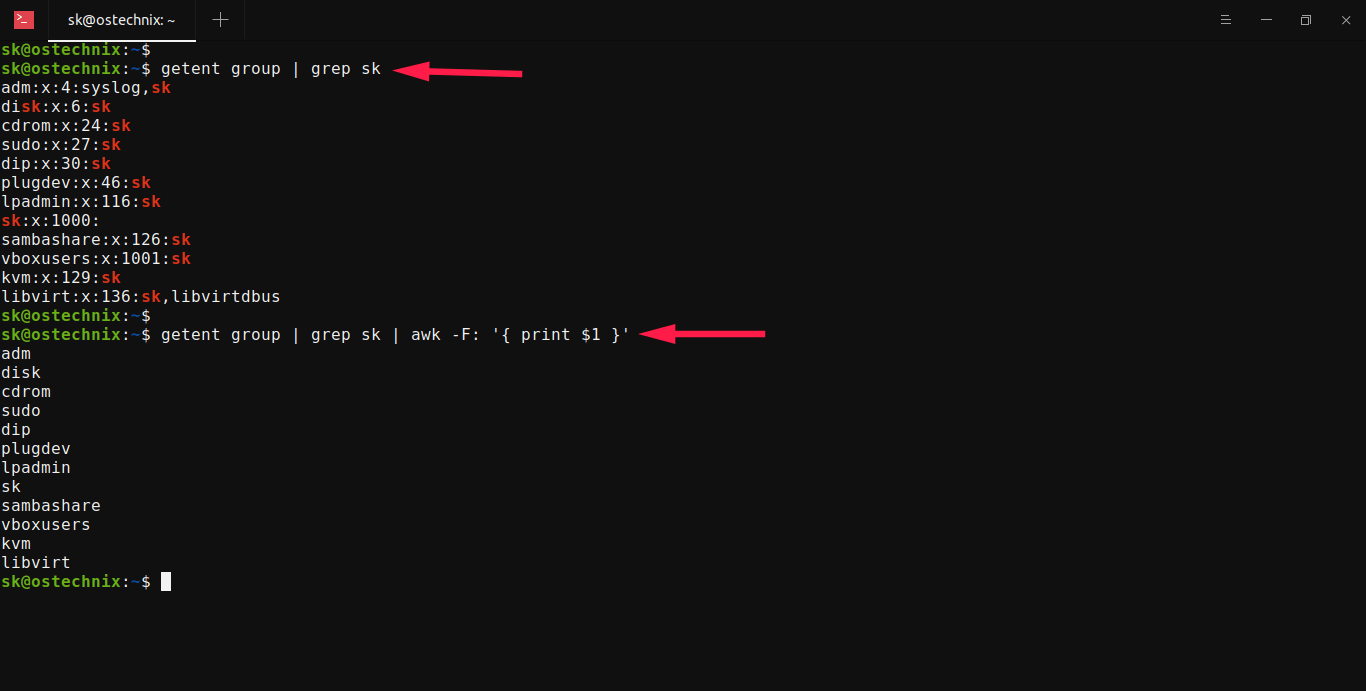- Linux Show All Members of a Group Command
- Linux Show All Members of a Group Commands
- Linux: List all members of a group using /etc/group file
- Display group memberships for each Linux user
- Linux List all members of a group using members command
- How to list all users in a Linux group using lid command
- To see users contained in group named ‘ftponly’:
- To show information about groups containing user named ‘nixcraft’:
- How to list groups in Linux
- Conclusion
- Linux / Unix Find All The Files Owned By a Particular User / Group
- Linux / Unix Find All The Files Owned By a Particular User / Group
- Find file owned by a group
- Find all *.mp4 files by group vivek
- Find file owned by user
- How to find files by users vivek and wendy
- Как вывести список групп в Linux
- Группы Linux
- Список всех групп, членом которых является пользователь
- Использование команды groups
- Используя команду id
- Список всех участников группы
- Список всех групп
- Выводы
- How To Find Out Which Groups A User Belongs To In Linux
- Find out which Groups a user belongs to in Linux
- Method 1 — groups command
- Method 2 — id command
- Method 3 — using «/etc/group» file
- Method 4 — getent command
- List all users belongs to a group in Linux
Linux Show All Members of a Group Command
Linux Show All Members of a Group Commands
- /etc/group file – User group file
- members command – List members of a group
- lid command (or libuser-lid on newer Linux distros) – List user’s groups or group’s users
| Tutorial details | |
|---|---|
| Difficulty level | Easy |
| Root privileges | Yes |
| Requirements | None |
| Est. reading time | 1m |
There are two types of groups in Linux:
- Primary group – is the main group that is associated with user account. Each user is a member of exactly one primary group.
- Secondary group – used to provide additional rights to user. For example, access to the dvd/cdrom drive can be granted with help of cdrom group.
Linux: List all members of a group using /etc/group file
Use the grep command or cat command/more command as follows:
$ grep ‘grpup-name-here’ /etc/group
$ grep ‘ftponly’ /etc/group
$ cat /etc/group
$ less /etc/group
$ grep -i —color ‘ftponly’ /etc/group
We can also type the compgen command or getend command to list all group names on Linux:
$ compgen -g
$ getent group
To get just a list of all members of a group called ftponly , type the following awk command:
Display group memberships for each Linux user
Want to see group memberships for each given USERNAME under Linux? The syntax is as follows for the groups command:
groups
groups
groups vivek
The following outputs indicates that the user named ‘vivek’ is part of four groups including ‘vivek’ primary group:
Linux List all members of a group using members command
Warning: members command is not installed on most Linux distros. Use yum command or apt-get command/apt command to install the same:
$ sudo apt-get install members
To outputs members of a group called ftponly, enter:
$ members
$ members ftponly
Fig. 01: members command in action to list members in a group
How to list all users in a Linux group using lid command
You can displays information about groups containing user name, or users contained in group name using lid command as follows.
Warning: lid command is not installed on most distros. Use yum command or apt-get command to install the same:
$ sudo apt-get install libuser
To see users contained in group named ‘ftponly’:
# lid -g ftponly
Please note that newer version of libuser renamed the lid command to libuser-lid . Thus, use it as follows:
$ sudo libuser-lid -g ftponly
Sample outputs:
To show information about groups containing user named ‘nixcraft’:
Use lid command or libuser-lid command on Linux to show all members of a group named nixcraft:
# lid nixcraft
OR
$ sudo libuser-lid nixcraft
Sample outputs:
See lid command man page for more information.
How to list groups in Linux
To see all users, run less command/more command:
less /etc/group
OR
more /etc/group
Another option is to type the following getent command:
getent group
For example, locate the members of a group with the name vboxusers, run:
getent group vboxusers
Sample outputs indicating vivek and raj users are part of vboxusers group:
- No ads and tracking
- In-depth guides for developers and sysadmins at Opensourceflare✨
- Join my Patreon to support independent content creators and start reading latest guides:
- How to set up Redis sentinel cluster on Ubuntu or Debian Linux
- How To Set Up SSH Keys With YubiKey as two-factor authentication (U2F/FIDO2)
- How to set up Mariadb Galera cluster on Ubuntu or Debian Linux
- A podman tutorial for beginners – part I (run Linux containers without Docker and in daemonless mode)
- How to protect Linux against rogue USB devices using USBGuard
Join Patreon ➔
Finally, you can use the id command to display real and effective user and group IDs:
id
id vivek
id -nG raj # show all group IDs for raj user
id -ng raj # show only effective group ID for raj user
Conclusion
Now you know how to use various Linux commands to show all members of a group. I suggest you read the man pages for more info by typing the following man command:
$ man libuser-lid
$ man members
🐧 Get the latest tutorials on Linux, Open Source & DevOps via
Источник
Linux / Unix Find All The Files Owned By a Particular User / Group
Linux / Unix Find All The Files Owned By a Particular User / Group
Let us see how to use the find command to locate all files/folders owned by one or many users on Linux or Unix-like system.
Find file owned by a group
| Tutorial details | |
|---|---|
| Difficulty level | Easy |
| Root privileges | Yes |
| Requirements | Linux or Unix |
| Est. reading time | 2m |
Use the following syntax to find files owned by users(s) in Linux/Unix:
find directory-location -group < group-name >-name < file-name >
Where,
- directory-location : Locate the file in this directory path.
- -group
: Find the file belongs to group-name. - -name
: The file name or a search pattern
In this example, locate or find all files belongs to a group called “ftpusers” in the /home directory:
# find /home -group ftpusers
To find all *.c file belongs to a group called “ftpusers” in /data/project directory, run:
# find /data/project -group ftpusers -name «*.c»
OR do case insensitive search:
# find /data/project -group ftpusers -iname «*.c»
Find all *.mp4 files by group vivek
Find file owned by user
The syntax is:
find directory-location -user < username >-name < file-name >
Where,
- directory-location : Locate files or directories in this directory location.
- -user < user-name >: Find the file belongs to user.
- -name
: File name or pattern.
In this example, locate or find all file belongs to a user called “vivek” in /var directory:
# find /var -user vivek
To find all *.pl (perl files) file belongs to a user called “vivek” in /var/www directory, enter:
# find /var/www -user vivek -name «*.pl»
- No ads and tracking
- In-depth guides for developers and sysadmins at Opensourceflare✨
- Join my Patreon to support independent content creators and start reading latest guides:
- How to set up Redis sentinel cluster on Ubuntu or Debian Linux
- How To Set Up SSH Keys With YubiKey as two-factor authentication (U2F/FIDO2)
- How to set up Mariadb Galera cluster on Ubuntu or Debian Linux
- A podman tutorial for beginners – part I (run Linux containers without Docker and in daemonless mode)
- How to protect Linux against rogue USB devices using USBGuard
Join Patreon ➔
How to find files by users vivek and wendy
### match files only ##
# find / -type f -user vivek -o -user wendy
### match dirs only ##
# find / -type d -user vivek -o -user wendy
Conclusion
You just learned how to find all of the files created by a particular user/group and display them to the screen. For more info see find command man page.
🐧 Get the latest tutorials on Linux, Open Source & DevOps via
Источник
Как вывести список групп в Linux
В Linux группа — это совокупность пользователей. Основная цель групп — определить набор привилегий, таких как разрешение на чтение, запись или выполнение для данного ресурса, которые могут быть совместно использованы пользователями внутри группы. Пользователи могут быть добавлены в существующую группу, чтобы использовать предоставляемые ею привилегии.
В этом руководстве объясняется, как показать все группы, в которые входит пользователь. Мы также объясним, как составить список всех членов группы.
Группы Linux
Пользователь может принадлежать к двум типам групп:
Первичная группа или группа входа в систему — это группа, которая назначается файлам, создаваемым пользователем. Обычно имя основной группы совпадает с именем пользователя. Каждый пользователь должен принадлежать ровно к одной основной группе.
Вторичная или дополнительная группа — используется для предоставления определенных привилегий набору пользователей. Пользователь может быть участником нуля или нескольких вторичных групп.
Список всех групп, членом которых является пользователь
Есть несколько способов узнать, к каким группам принадлежит пользователь.
Основная группа пользователей хранится в /etc/passwd а дополнительные группы, если таковые имеются, перечислены в /etc/group .
Один из способов найти группы пользователей — перечислить содержимое этих файлов с помощью cat , less или grep . Другой более простой вариант — использовать команду, цель которой — предоставить информацию о пользователях и группах системы.
Использование команды groups
Самая запоминающаяся команда для вывода списка всех групп, членом которых является пользователь, — это команда groups . При выполнении без аргумента команда распечатает список всех групп, к которым принадлежит текущий зарегистрированный пользователь:
Первая группа — это основная группа.
Чтобы получить список всех групп, к которым принадлежит конкретный пользователь, укажите имя пользователя для команды groups в качестве аргумента:
Как и раньше, первая группа является первичной.
Используя команду id
Команда id выводит информацию об указанном пользователе и его группах. Если имя пользователя не указано, отображается информация для текущего пользователя.
Например, чтобы получить информацию о пользователе linuxize вы должны ввести:
Команда покажет идентификатор пользователя ( uid ), основную группу пользователя ( gid ) и вторичные группы ( groups ) пользователя.
Чтобы напечатать только имена вместо чисел, используйте параметр -n . Опция -g выведет только основную группу и -G все группы.
Следующая команда напечатает имена групп, членом которых является текущий пользователь:
Список всех участников группы
Чтобы getent group список всех членов группы, используйте команду getent group за которой следует имя группы.
Например, чтобы узнать членов группы с именем « developers , воспользуйтесь следующей командой:
Если группа существует, команда напечатает группу и всех ее членов:
Если нет вывода, это означает, что группа не существует.
Список всех групп
Чтобы просмотреть все группы, присутствующие в системе, просто откройте файл /etc/group . Каждая строка в этом файле представляет информацию для одной группы.
Другой вариант — использовать команду getent которая отображает записи из баз данных, настроенных в файле /etc/nsswitch.conf включая базу данных group которую мы можем использовать для запроса списка всех групп.
Чтобы получить список всех групп, введите следующую команду:
Вывод такой же, как при отображении содержимого файла /etc/group . Если вы используете LDAP для аутентификации пользователя, getent отобразит все группы как из файла /etc/group и из базы данных LDAP.
Вы также можете использовать awk или cut для печати только первого поля, содержащего имя группы:
Выводы
В этом руководстве вы узнали, как найти группы, членом которых является пользователь. Те же команды применимы для любого дистрибутива Linux, включая Ubuntu, CentOS, RHEL, Debian и Linux Mint.
Не стесняйтесь оставлять комментарии, если у вас есть вопросы.
Источник
How To Find Out Which Groups A User Belongs To In Linux
A Linux group is a collection of one or more users with identical permission requirements on files and directories. An user can be a member of more than group at a time. In Linux, each group information is stored in the «/etc/group» file. In this tutorial, we will see all the possible ways to easily find out which groups a user belongs to in Linux and Unix-like operating systems.
Finding out the groups to which a user account belongs will be helpful in many occasions. For instance, the other day I was installing Dropbox on my Ubuntu server. When configuring Dropbox, I had to enter my current user name and the group name. You could also be in a situation where you need to identify the groups a user belongs to. If so, use any one of the following methods to know what group a user is in.
Find out which Groups a user belongs to in Linux
There are many ways to list the groups that a Linux user is a member of. The most commonly used method is by using groups command.
Method 1 — groups command
The groups command displays the current group names and the users belongs to those groups in Linux and Unix-like operating systems.
First, let us find how many groups are there in our Linux system.
To find the list of available in Linux, run the groups command without any arguments like below:
Sample output:
List available groups in Linux
As you can see in the above output, there are currently 12 groups in my system.
Now, find out which groups a specific user, for example sk, belongs to. To do so, enter «groups» command followed the username like below:
Sample output:
Find out which Groups a user belongs to in Linux using groups command
Here, sk is my username and the user sk is the member of all of the above groups. You might have noticed that «sk» is listed twice. Because, I have used the same name for both username and group name.
For more details about «groups» command, refer man pages.
Method 2 — id command
The another way to identify the groups a user is in is by using «id» command. The id command is used to print user and group information for the specified USER. If the USER is not specified, it will print the information for the current user.
To identify all the groups that a user belongs to using «id» command, run:
Replace sk with your username.
Sample output:
Find out which Groups a user belongs to in Linux using id command
As you see here, the id command not only lists the groups that user is member of, but also group id and user id (UID and GID) of the given user and the groups. It has more verbose output than the «groups» command, so if you need the group id/user id use this!
If you don’t want to print the numbers, simply use -Gn flag like below:
For more details, refer the man pages.
Method 3 — using «/etc/group» file
As I stated already, the /etc/group file contains the information about each group in a Linux system. You can find which groups the given user belongs to from the contents of the /etc/group file with the help of «grep» command as shown below:
Sample output:
If you want to exclude the group ids and the username and display only the group names, pipe the «grep» command’s output to «awk» command like below:
Sample output:
Find which Groups a user belongs to in Linux using grep and awk commands
Method 4 — getent command
The «getent» command displays entries from databases supported by the Name Service Switch libraries, which are configured in /etc/nsswitch.conf file.
We can list all available groups and their members in a Linux system using getent command like below:
To find which groups a specific user (E.g. sk) belongs to, run:
Sample output:
If you want to display only the groups excluding all other details, filter the output with «grep» and «awk» commands like below:
Find which Groups a user belongs to in Linux using getent, grep and awk commands
List all users belongs to a group in Linux
We can also find the list of all users that belongs to a specific group. For instance, the following command displays the users which are belongs to the group named storage.
Easy, right? Indeed. Finding which groups a user belongs and the users of a specific group is super easy!!
Источник








